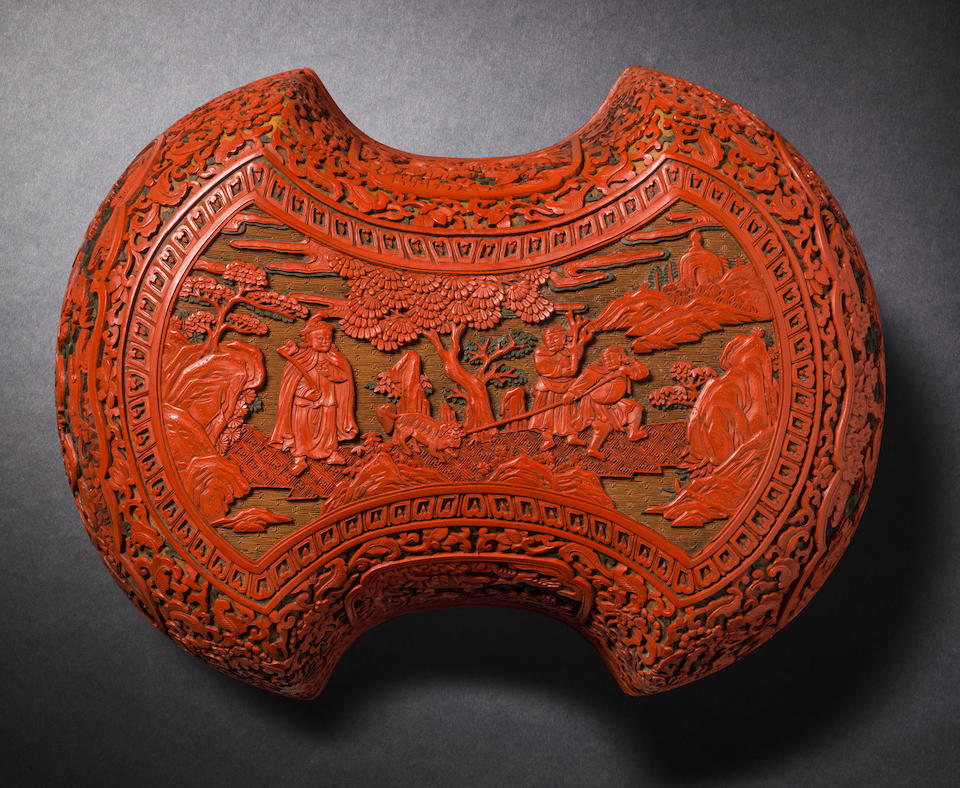
Lot 19. A rare large three-colour cinnabar lacquer 'ingot' box and cover, Qianlong period (1736-1795); 30cm (11 3/4in) wide. Estimate HK$300,000-400,000. Sold for HK$ 525,000 (€ 62,729). Photo: Bonhams.
The steeply curved sides rising from a splayed foot, the cover intricately carved through multiple layers of red, black and yellow lacquer with a Buddhist landscape scene of a Karmapa wearing his iconic Black Crown and holding a wish-granting ruyi-head sceptre in one hand, his disciples holding coral and another subduing a Buddhist lion, the sides elaborately decorated with eight quatrefoil and ruyi-shaped cartouches enclosing deer and cranes on a deeply carved trefoil ground, all interspersed with meandering lotus tendrils between borders of keyfret scroll and lotus lappets, the interior and base lacquered black, wood stand.
Provenance: An English private collection.
Note: The present lot is very rare for its combination of impressive size and the ingot form, offering many auspicious connotations and masterfully carved in three-colour lacquer. It is a testament to the skilful craftsmanship achieved by the lacquer ateliers at the height of the Qing dynasty.
Gold and silver ingots, known as yuanbao 元寶, were used in ancient China as a form of currency and therefore, the ingot form came to symbolise prosperity and wealth. The Chinese character for 'ingot' (ding 錠) is formed of two radicals or components: the left is that of 'gold' (jin 金) and the right is that of 'certainty' (ding 定). Together they form the pun for 'wealth will come most certainly'. The auspicious symbolism is further reinforced by the deer (lu 鹿) which signifies longevity, and the crane (he 鶴), which is a homophone for 'togetherness' (he 合), with both often shown beside Shoulao, the God of Longevity. Since there are six cranes depicted on the present lot, they form the rebus liuhe tongchun 六合同春, meaning 'the universe is enjoying springtime and longevity'. Furthermore, the iconography of the ingot (ding 錠), sceptre (ruyi 如意) and coral (shanhu 珊瑚) form three of the Eight Treasures (babao 八寶), which are commonly seen on Buddhist-themed objects. For a lacquer example with the babao motif, see a lobed cinnabar lacquer box and cover from the Jiajing period in the Huaihaitang collection, illustrated in The Radiant Ming 1368-1644. Through the Min Chiu Society Collection, Hong Kong Museum of History, 2015, p.205, no.151.
Ingot-shaped lacquer examples first appeared in the Ming dynasty; see a tianqi lacquer ingot-shaped box and cover, Jiajing mark and period, from the Qing Court Collection, illustrated in The Complete Collection of Treasures of the Palace Museum: Lacquer Wares of the Yuan and Ming Dynasties, Shanghai, 2006, pl.152; and a carved cinnabar lacquer ingot-shaped box and cover, Jiajing mark and period, illustrated in P.Frick, Chinesische Lackkunst: Eine Deutche Privatsammlung, Münster, 2010, no.20. A very similar carved cinnabar lacquer ingot-shaped box and cover, Qianlong, from the Shibuyaku Shoto Museum, is illustrated in Kaikan Jusshunen Kinen Tokubetsu-ten: Chugoku no Urushi Kogei, Tokyo, 1991, no.79.
Bonhams. Fine Chinese Ceramics and Works of Art, Hong Kong, 2 June 2016

/https%3A%2F%2Fprofilepics.canalblog.com%2Fprofilepics%2F1%2F0%2F100183.jpg)
/https%3A%2F%2Fstorage.canalblog.com%2F03%2F02%2F119589%2F96711876_o.jpg)
/https%3A%2F%2Fstorage.canalblog.com%2F11%2F31%2F119589%2F94773502_o.jpg)
/https%3A%2F%2Fstorage.canalblog.com%2F20%2F83%2F119589%2F94772815_o.jpg)
/https%3A%2F%2Fstorage.canalblog.com%2F26%2F72%2F119589%2F75604929_o.jpg)
/https%3A%2F%2Fstorage.canalblog.com%2F59%2F60%2F119589%2F26458628_o.jpg)



/image%2F1371349%2F20240329%2Fob_17ee91_115-1.jpg)
/http%3A%2F%2Fstorage.canalblog.com%2F58%2F48%2F119589%2F129604373_o.jpg)
/http%3A%2F%2Fstorage.canalblog.com%2F07%2F92%2F119589%2F129516999_o.jpg)
/http%3A%2F%2Fstorage.canalblog.com%2F98%2F60%2F119589%2F129446628_o.jpg)